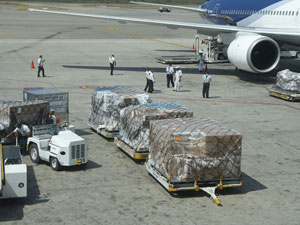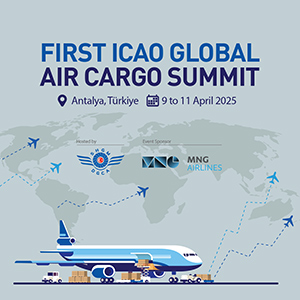Still, there was insufficient capacity to meet demand as a result of the loss of belly cargo operations on passenger aircraft.
- Global demand, measured in cargo tonne kilometers (CTKs), fell by 27.7% in April compared to the previous year (-29.5% for international markets).
- Global capacity, measured in available cargo tonne kilometers (ACTKs), shrank by 42% in April compared to the previous year (-40.9% for international markets).
- Belly capacity for international air cargo shrank by 75% in April compared to the previous year. This was partially offset by a 15% increase in capacity through expanded use of freighter aircraft.
- The cargo load factor (CLF) rose 11.5 percentage points in April, the largest increase since tracking began. The magnitude of the rise suggests that there is significant demand for air cargo which cannot be met owing to the cessation of most passenger flights.
“There is a severe capacity crunch in air cargo. Demand fell by 27.7% compared to April 2019. But capacity was down 42% because of the sharp cuts in passenger operations which also carry cargo. The result is damaging global supply chains with longer shipping times and higher costs. Airlines are deploying as much capacity as possible, including special charter operations and the temporary use of passenger cabins for cargo. Governments need to continue to ensure that vital supply lines remain open and efficient. While many have responded with speed and clarity to facilitate the movement of cargo, government red-tape—particularly in Africa and Latin America—is preventing the industry from flexibly deploying aircraft to meet the demands of the pandemic and the global economy,” said Alexandre de Juniac, IATA’s Director General and CEO.
Delays in getting operational permits issued, blockages at the border and inadequate ground infrastructure to/from and within airport environments continue to hamper air cargo in countries in Africa and Latin America. Air cargo needs to move efficiently throughout the entire supply chain to be effective. IATA urges governments to:
- Accelerate approvals for cargo operations
- Expedite customs clearance for urgently needed medical supplies
- Ensure there is adequate staff on the ground and land-based infrastructure to move cargo efficiently
Regional Performance
| |||||||||||||||||||||||||||||||||||||||||||||||||
1 % of industry CTKs in 2019 2 Year-on-year change in load factor 3 Load factor level |
- Asia-Pacific airlines saw demand for international air cargo fall by 28.1% in April 2020, compared to the same period a year earlier. However, the large Asia-North America market recorded less of a decline (7.3%) due to the rise in movement of personal protective equipment (PPE). International capacity decreased 42.5%.
- North American carriers reported a fall in international demand of 20.1% year-on-year in April. This was the smallest contraction of all regions. While still a significant drop, it remains less than the decline seen at the height of the Global Financial Crisis in April 2009 (-32.3%). International capacity decreased 27.7%.
- European carriers reported a 33.8% annual drop in international cargo volumes in April, much sharper than the outcome for March (-18.5%). However, the large Europe-Asia market recorded less of a decline due to the rise in movement of PPE. International capacity decreased 46.9%.
- Middle Eastern carriers reported a decline of 36.2% year-on-year in April, significantly worse than 14.1% fall in March. Despite a number of carriers in the region maintaining some cargo capacity, traffic on all key routes was low. International capacity decreased 42.4%.
- Latin American carriers posted the sharpest fall—a 38.9% year-on-year decline in international demand. International capacity decreased 55.5%. The COVID-19 crisis is particularly challenging for airlines based in Latin America owing to strict containment measures and a lack of support from Governments to keep cargo moving.
- African airlines were less affected by disruptions from COVID-19 than other regions in April. They saw year-on-year international CTKs fall by 20.9%. The small Africa-Asia market was the most resilient route in April, down only 1.0%. International capacity decreased 36.6%.




























Türkçe karakter kullanılmayan ve büyük harflerle yazılmış yorumlar onaylanmamaktadır.